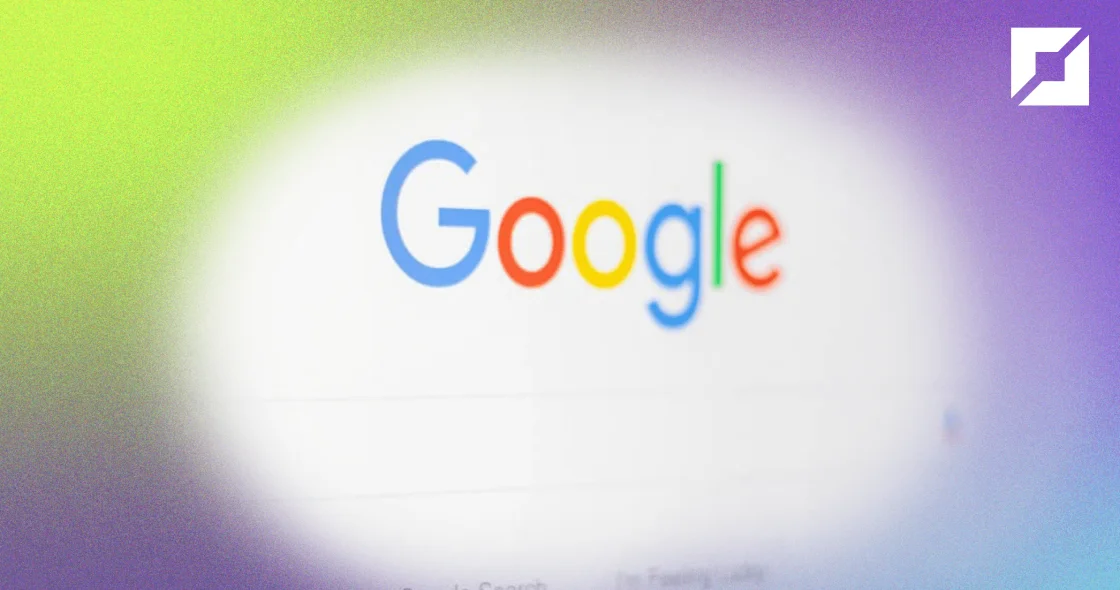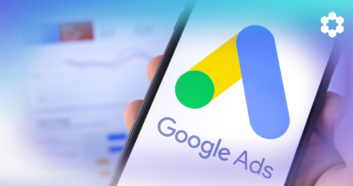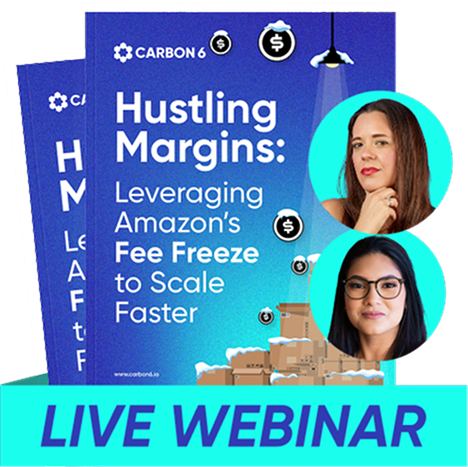When it comes to Google Ads for B2B lead generation, there’s multiple tactics you can use to increase CTR & conversions and ultimately improve your ROAS (Return on Ad Spend).
To help you boost your ads ROI and generate leads, below you’ll find 11 compelling Google Ads from growing businesses, along with key features each of them use to inspire your next PPC search campaign.
To start, we’ll briefly cover the benefits of Google’s ad platform, as well as the anatomy of a Google Ad to get you primed for launching ads that convert 🚀.
Why Use Google Ads?
Probably every B2B advertiser we’ve talked to invests in Google Ads, simply because they work for customer acquisition.
Our customers have also found they’re more cost effective than other ads platforms. We’ve successfully confirmed this from our own ads experiences at PixelMe, as Google Ads have brought us the most signups at the lowest CPAs to date this year.
More top reasons why it’s a powerful ads platform:
- 💰 Proven ROI: Businesses make an average of $2 in revenue for every $1 they spend on Google Ads (source: Google Economic Impact Report).
- 🎯 Massive reach: Google has 90% of the global search engine market share, and there’s 3.5B Google searches made daily. This means there’s a good chance (with ongoing testing) that you’ll be able to find customers in your target audiences.
- 🏢 Social proof: Today, Google Ads (aka AdWords until July 2018) has 45% of SMBs in the US using it to find new customers. By the numbers, that’s over 1.5M businesses in the US running Google Ads, so there must be something working for so many companies 😉.
- Warm leads: People on Google have an intent to search, discover, and buy. So it’s a great channel to dial into people that are actively in the purchase mindset, and more easily move them down your conversion funnel.
Google Search Ads Components
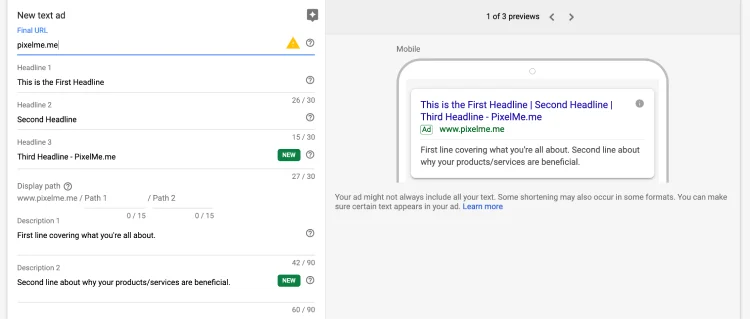
As a refresher, the 3 basic parts of a Google Search ad include:
- Headline: The first bolded line people see. You can create up to 3 headlines with up to 30 characters per headline.
- Display URL: The ad destination page.
- Description: You can include 2 lines of text about your products & services. Each description is limited to 90 characters.
From these elements, it comes down to highlighting your company’s unique selling points, tailoring your message to the audience you’re targeting, including clear CTAs that make it easy for people to convert, and testing various feature add-ons Google provides.
Let’s dive into all the ways companies optimize their Google Ads and how you can do the same!
11 Top Google Ads Examples
1. Mailchimp: Include Sitelink Extensions
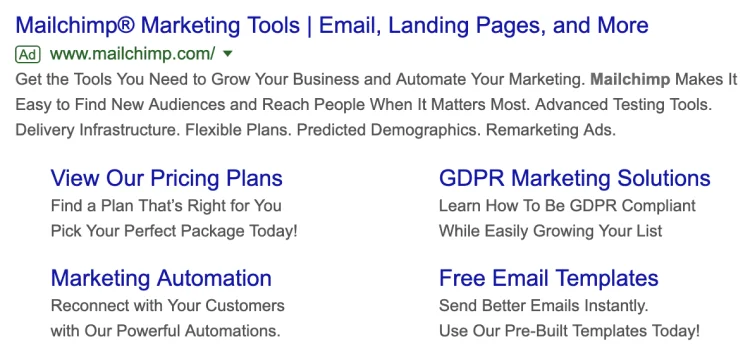
Mailchimp includes 4 different sitelink extensions on their Google Ads to give more info about their pricing plans, GDPR for European customers, key features, and free email tools.
Sitelinks take people to key pages on your site that complement your ad text, and give people more opportunity to learn about your products, pricing, features, success stories, request a demo, and more. It’s super easy to add sitelinks and they can even give your ads a 10% increase in CTR.
🔥 Pro-tip
- Add descriptions to your sitelinks to make them more relevant for potential customers, while increasing the real estate of your ads to capture people’s attention more easily.
2. Zapier: Provide Clear CTAs
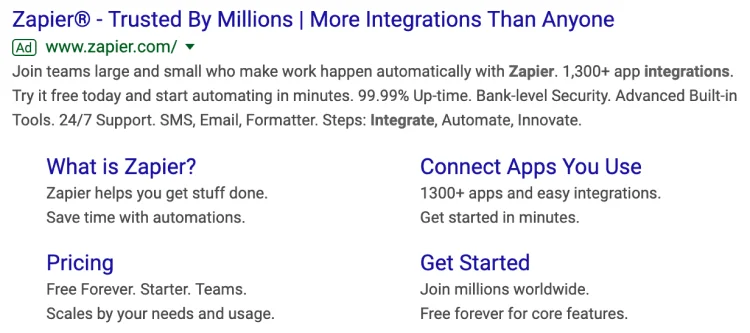
Zapier has concise and snappy CTAs in their ads: “Try it free today and start automating in minutes.”
In each of their sitelink extensions, they also include short and clear CTA on the benefits and ease of getting started for free.
Though it might seem like one of the most basic elements of an ad, including specific CTAs (e.g. signup today, request demo, download guide) will (not surprisingly) lead more people to take key actions that matter to you.
3. LinkedIn: Optimize Landing Pages

LinkedIn takes people to vertical landing pages that are tailored to specific audiences, such as B2B Marketers. They also tweak their ads copy to specific keywords used in search, for a doubly effective ad.
Landing pages are particularly beneficial in Google Ads, as you can create content customized to people in certain industries and/or searching for certain keywords or topics. This in turn can better convert them vs. taking them to your homepage that likely includes broader content.
🔥 Pro-tip
- To increase your conversion rates, try retargeting people who clicked on your Google Ads with ads from another platform your audience is likely to be active in, such as Facebook.
4. Drift: Differentiate from Competitors

Drift specifically calls out their competitor Intercom. They highlight key features they provide vs. Intercom, as well as social proof in the number of businesses who use them, and their free plan.
If you have a lot of big competitors in your industry, targeting your ads at competitor keywords, and including comparison keywords are another great way to zone in on likely customers.
🔥 Pro-tip
- Neil Patel’s free Ubersuggest tool lets you find monthly search volume by keywords across countries so you can plan around keywords to target and even include in your ad creative. Other great features: it shows you “paid difficulty” (estimated competition in paid search) and CPC (estimate cost per click on Google).
5. Airtable: Add Social Proof
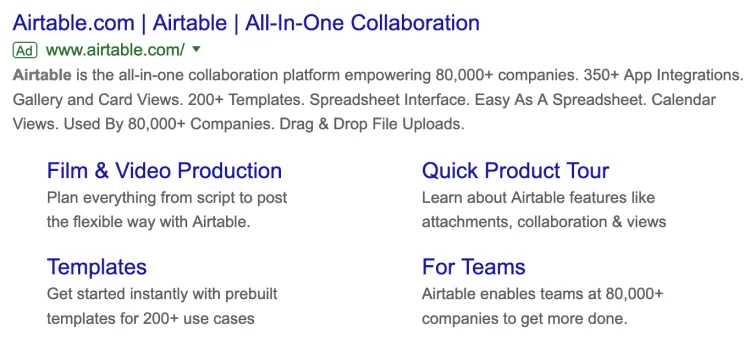
Airtable emphasizes twice that there’s 80,000+ companies who use them, helping validate their market presence.
Featuring key company usage stats is a strategy used by many businesses in their Google Ads. It can be an effective callout for reassuring potential customers they’re in good company, by telling them there’s many other businesses finding success with your tools.
6. Dropbox: Provide Free Trials
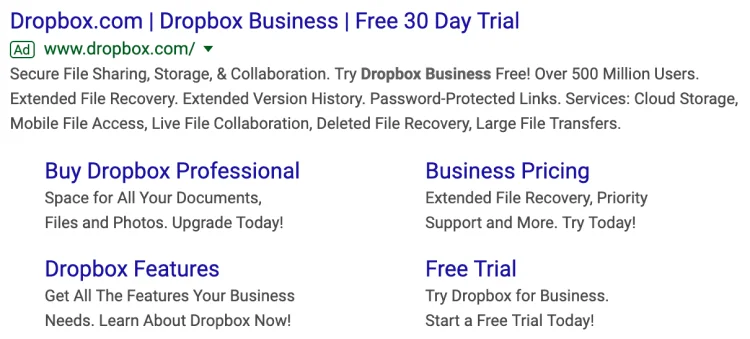
Dropbox Business promotes their free 30-day trial in their ad headline and also includes a specific sitelink extension for their free trial.
If you’re a B2B SaaS business, it may be worth testing a free trial to give users a taste of your product. It’s served us well at PixelMe for our Audience Builder product, as it’s easy to setup and people can quickly see value from it, leading them to become a paid subscriber.
7. Zendesk: Include Price Extensions
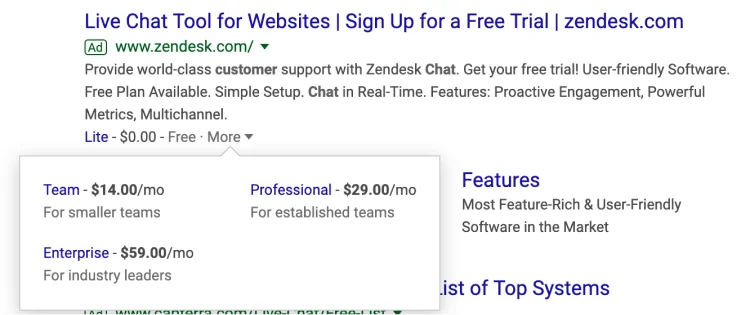
Zendesk includes price extensions their Google Ads, which are additional snippets of pricing info about your specific products or services.
When you click on “More” next to their free Lite plan, you’ll see all their different pricing plans, along with costs, who the plans are for, and links to find out more.
Adding pricing extensions can help people quickly evaluate if your services fit their budget, and reduce any drop-offs when they get to the consideration stage later on.
🔥 Pro-tip
- Google’s FAQ covers how to setup price extensions, character limits, and requirements for each price extension type
8. ActiveCampaign: Include Call Extensions
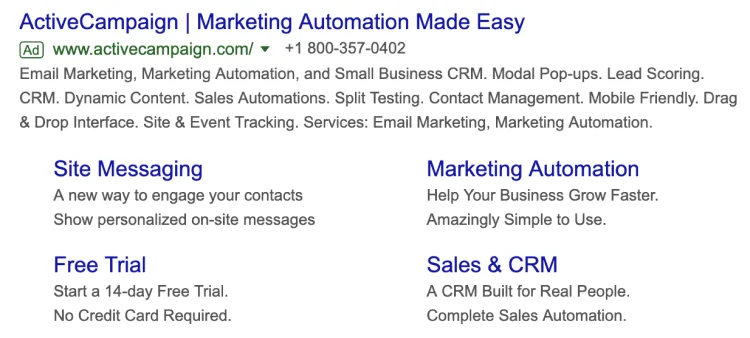
ActiveCampaign, an email and marketing automation software includes call extensions to their toll-free number that lets people get in touch with their Sales team.
If you have a sales contact number, it’s another good way to help people with high interest contact you directly. And it can also help increase CTR since it shows you have a team that’s easy to reach in the evaluation stage.
🔥 Pro-tip
- Google’s FAQ covers how call extensions work and how to get started.
9. WordStream: Keep Text Conversational
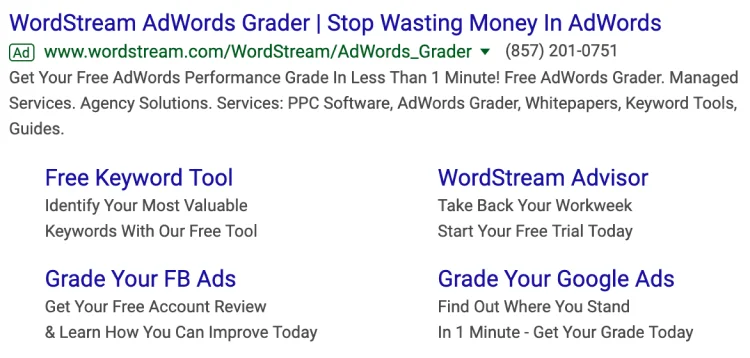
Writing like you talk might seem like a common best practice, but it’s unfortunately commonly ignored in many Google Ads we’ve come across.
Wordstream does a great job at keeping their description concise, readable, benefits-oriented, and pointed to just the most important facts.
🔥 Pro-tip
- Be creative when A/B testing different ad messaging (e.g. social proof, pricing, limited-time promotions, etc.) to highlight different value props and benefits, and monitor which ones result in higher CTR and conversions.
10. Monday: Include Review Extensions

Monday shows the average number of star ratings and reviews from customers.
Star ratings and reviews are a major CTR and purchase driver, so being able to showcase these in your ads can also be very beneficial for making your business stand out and increasing CTR and customers.
🔥 Pro-tip
- Google’s FAQ covers how seller ratings work in ad extensions. Since seller ratings are an automated extension, you can’t directly opt to include them in your ads. However, you can optimize for getting them automatically shown by ensuring you’re getting plenty of customer reviews in any of the independent review sites they source feedback from. E.g. In Monday’s case, they currently have 300+ reviews on TrustPilot.
11. GitLab: Develop Free Guides
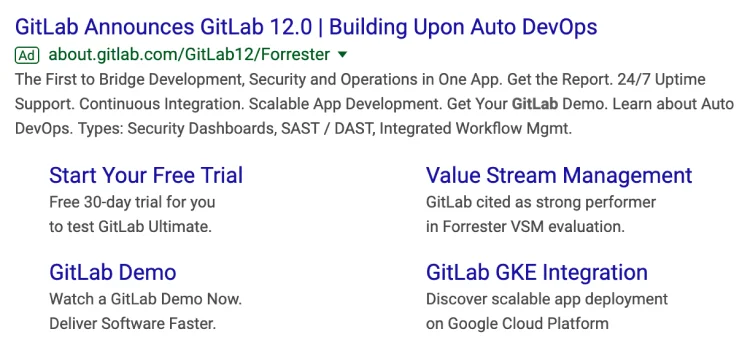
GitLab promotes key content that’s aligned with what potential customers in the DevOps space would be searching for.
In their ads, they test taking people to download free guides for studies they conducted on software development pain points and recommendations for using their own suite of tools.
🔥 Pro-tip
- If your sales cycles are typically long and require extensive research and multiple stakeholders from your target buyers, you can also consider developing more established content in the form of guides, whitepapers, and e-books that position you as a thought leader and keep you top of mind.
12. Bonus: Measure ROI with PixelMe
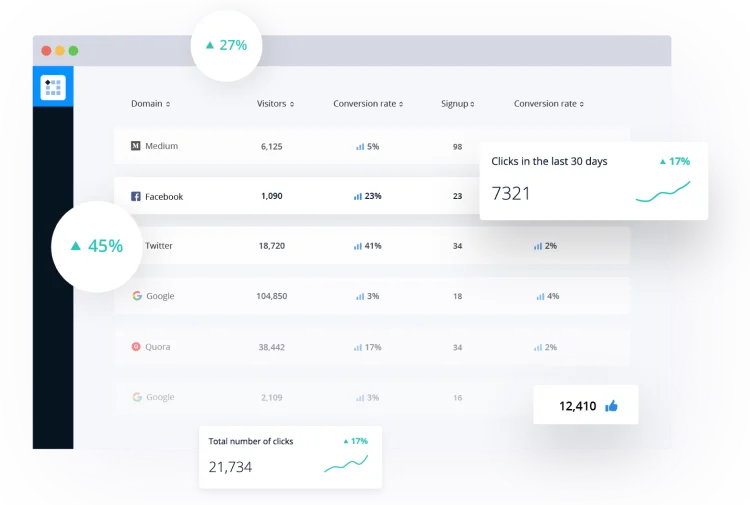
As an advertiser, what matters in the end is creating Google Ads that provide a high ROI. But what is your Google Ads ROI? And how does it compare to other ads platforms?
We’ve heard time and time again that automating the tracking of ROI across all your paid and non-paid channels is a major struggle.
Which is why we built Smart Attribution, to give you direct insights into your best marketing channels and how to optimize budgets. You’re able to:
- Measure ROI across multiple ads platforms (Google & Facebook).
- See which marketing channels & campaigns are most effective.
- Allocate more budget to channels that convert, and stop wasting money in ad platforms, campaigns, and channels that are underperforming.
Closing Thoughts
That wraps up 11 amazing examples of how top B2B companies create Google Ads that convert!
Running effective ads is really a trial-and-error process that takes ongoing testing to figure out what works for your business. So hopefully you now have some fresh ideas for getting the most out of your own Google Ads and growing customers.
Want to track your Google Ads & acquisition ROI? Sign up for a free 7-day PixelMe trial🎉.
